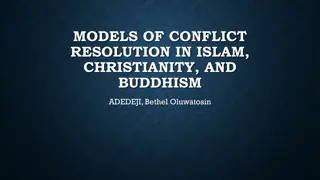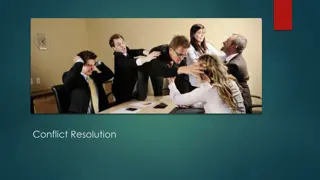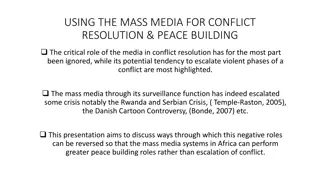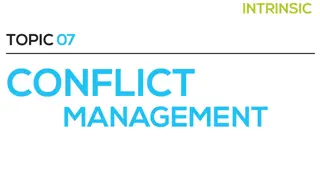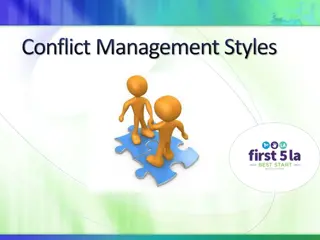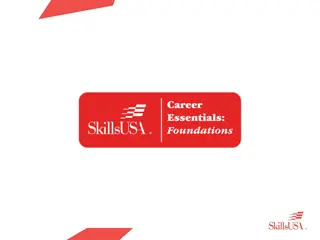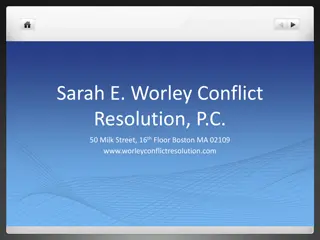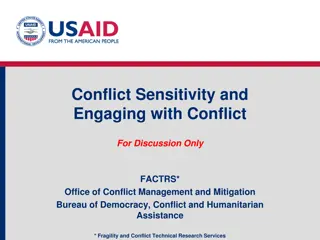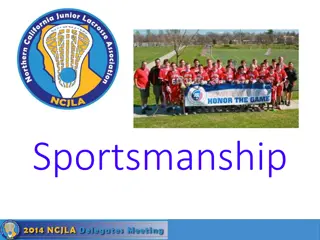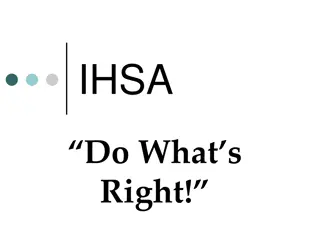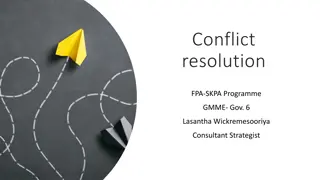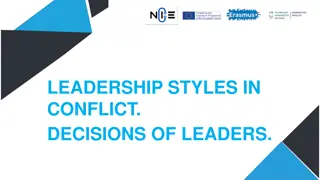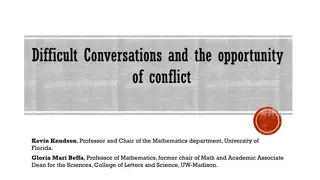Effective Conflict Resolution and Sportsmanship Strategies
Enhance conflict management skills by understanding and addressing conflicts peacefully, fairly, and decisively while upholding sportsmanship values. Learn to recognize, respond to, and manage conflicts effectively to maintain healthy relationships and emotional balance, essential in various aspects of life including work and sports.
Download Presentation

Please find below an Image/Link to download the presentation.
The content on the website is provided AS IS for your information and personal use only. It may not be sold, licensed, or shared on other websites without obtaining consent from the author.If you encounter any issues during the download, it is possible that the publisher has removed the file from their server.
You are allowed to download the files provided on this website for personal or commercial use, subject to the condition that they are used lawfully. All files are the property of their respective owners.
The content on the website is provided AS IS for your information and personal use only. It may not be sold, licensed, or shared on other websites without obtaining consent from the author.
E N D
Presentation Transcript
Extraordinary Conflict Resolution and Sportsmanship
Conflict Management If you know the enemy and know yourself, you need not fear the result of a hundred battles. If you know yourself but not the enemy, for every victory gained you will also suffer a defeat. If you know neither the enemy nor yourself, you will succumb in every battle. By Sun Tzu
Goal To resolve conflicts peacefully, fairly, and decisively To resolve conflicts peacefully, fairly, and decisively while remaining emotionally balanced and while remaining emotionally balanced and maintaining relationships as an example of maintaining relationships as an example of Sportsmanship. Sportsmanship.
Introduction Enhancing 2 wood cutters Experiences with Conflict Management Is there a need for Conflict Management in your job. How to recognize conflict. Respond to a conflict. Addressing emotions.
Definition Conflict is the result of disagreement caused by perceived or actual opposition of interests, needs and values. Conflict is any situation in which your concerns or desires differ from those of another person. Crucial Conversations, describes a conflict as; High stakes Disagreement Emotional
Conflict Types Internal External Is all conflict bad? (Sporting event)
Conflicts Occur When... Resources are limited and two or more parties want to access this resource There is no disparity of power between them They both feel entitled to the resource They both depend on each other and must use each other s services in the future
Sources of Conflicts Basic Needs Values Resources Interests Perceptions Love
Sources Easily Available Resources Power Disparity Impact
Conflict can be Counterproductive Lower productivity Increased stress Increased frustration due to time loss May lead to, You are either with us or against us Reduced trust Win/Lose or Lose/Lose mentality; decision made emotionally
Conflict can be Productive Increased creativity Encourages stronger emotional skills Encourage to become better negotiators Learn more about each other s needs (yours and theirs) Learn about other s values, culture and ideology Encourages to question the status quo Dad at the Glen L Martin Co
Eliminate all Conflict? Should you eliminate all conflicts within your team? Conflicts must be considered as a natural part of team development. Enabling productive conflicts in teams can benefit all parties and reduce emotional stress.
Baron and Baroness Baron dictates Baroness stays in Castle Staff told let no one pass Who is responsible?
Conflict Resolution Options Lose/Lose Win/Lose Win/Win
Our Needs If we feel our needs are not being met conflict occurs, how do we resolve? Understand (weigh-in to buy-in) Communicate with the Three S s State the facts Story Their Side Negotiate Active role in responding
Personality During Conflict It is beneficial to know the characteristics of each person in a conflict, so you can quickly address Determine which state they are demonstrating and may be heading towards
Audience Personality Styles Data Processor Bottom Liner Peace Maker Creative
Conflict Life Cycle Quiet to Riot (Silence to Violence) Where are others Where are you How do we become more effective and resolvers?
Conflict Life Cycle Annoyance Frustration Anger Violence
The Cycles How does it start and what are its characteristics as it escalates? Annoyance. At this stage, the problems are simply annoying. You would rather not have the problem, but its existence is not a showstopper. Frustration. The problem is getting bigger and is starting to frustrate you. Concerns are voiced and arguments are structured logically. Anger. There is a feeling concerns are neglected and a conflict is developing. Objections are becoming more emotional and people are feeling hurt by the injustice. Needs are not met and people don t feel good about it. Violence. Matters are now taken personally. There is a need to win at all costs just to prove the point. The reaction may become physical because words don t seem to have any effect anymore. In extreme cases, people may quit, go on strike, fight, rebel or initiate a revolution.
Win / Win Win / Lose Lose / Lose Hardening of Positions Action, Not Words Hidden Conflict Intense Debate Lost of Face Splitting Up Coalitions Compete breakup Threats Knowing the signs of conflict escalation can be used to prevent intensification and to resolve the conflict.
Signs of Escalation of Conflicts Emotions overwhelm facts Fear and distrust dominate Perspective is black and white Information is restricted Solutions are no longer interesting
Remember You can control 20% of what you feel. You can control 80% of your behavior. You can control 100% of your decisions. It is your reaction to the situation that determines a conflict. The second word creates the quarrel Arguing with a crazy person only proves that there are two of them.
Exploration You have overcharged me I do not have the correct change Stick to facts Avoid becoming emotional
Exploration In this step; Explore options and try to understand the other side. Seek and provide facts. Stick to facts and try not to become emotional about issues. Facts are more difficult to dispute and easier to defend. Avoid attacking personalities. Focus on the task not the individual.
Arguments Exploration Discuss Each Side takes a position Stick to your goal Show you care Understanding
Arguments Best practices in this step; Stick to your goal. Don t be tempted to win the argument using all your energy, instead focus on your objective and try to find a compromise. Understand the other side s needs. The more you understand them, the easier it is to reduce the argument. Show you care about the other side and that their concern is is also your concern.
Options Exploration Arguments Explore possibilities Negotiate solutions Be creative
Options Creativity arises; Once the position of all parties are discussed and explored you can start working on potential options to resolve your dispute. This is when you may have to negotiate a solution. Discuss exploring different approaches to the goal. This stage highly depends on the perceived authority of each party, their resources, interests in getting to a reasonable solution and their previous history. Be very creative and look for options that satisfy the needs of all parties.
Resolution Exploration Arguments Options Commitment to solution Formal agreement Documentation 27,000 punch list Seek resolution Seek win/win Ask, don t tell
Managing Conflicts Understanding practice active listening Move to agreement Confronting Use third party
Thomas-Kilmann Conflict Mode Instrument (TKI) for Resolution The TKI measures preferences for five different styles of handling conflict Competing Accommodating Avoiding Collaborating Compromising
Thomas-Kilmann Conflict Mode Instrument (TKI) Know your Conflict Style Recognize the Conflict style of others Assess Conflict situations Practice using different modes parent to parent, youth to youth, coach to parent, in the workplace
Thomas-Kilmann Conflict Mode Instrument (TKI) Each conflict mode differs in terms of two basic aspects Assertiveness the degree to which a person attempts to satisfy his or her own concerns. Cooperativeness the degree to which a person attempts to satisfy the concerns of another person.
Thomas-Kilmann Conflict Mode Instrument (TKI) The five modes are described along two dimensions; Competing: high assertive and low cooperative goal to win Accommodating: high cooperative and low assertive goal yield Avoiding: low assertive and cooperative goal to delay Collaborating: high assertive and cooperative goal to win-win Compromising: in the middle on both dimensions goal find middle ground
Understanding the Conflict Modes Two basic aspects of all conflict- handling modes, your conflict mode depends on; Skill Situation
Thomas-Kilmann Conflict Mode Instrument (TKI) Know your Conflict Style Recognize the Conflict style of others Assess Conflict situations Practice using different modes Move the coffee pot
6-Step Specific Conflict Resolution Formula Confirm Agree with the other person Show Show that you care Understanding Prepare Glue statement Provide Reasons Logical statements and facts Deliver Alternate Statement You don t quite agree Offer Provide an alternative solution Compromise
Respond to Demands I need you to work overtime tonight to finish this urgent report; it has to be with customer at 10 am tomorrow. No, there is no way I can do this. I have to go home and babysit my children. Sorry!
Sure Confirm I understand the urgency of this case and how important it is to deliver it on time Show Understanding However I think you need to know that Prepare
I have been working overtime all week and kept tonight free to babysit my children Provide Reasons Deliver Alternate Statement So I am afraid I won t be able to stay long But Paul can work on this tonight and I will come in early tomorrow to do the finishing touches and finalise the report. Offer Compromise
Practice 6 Step Formula Your tone of voice in this email is not very professional, I would like you to write another email to this manager.
Manage Your Emotions Manage your emotions and influence others when in conflict
Emotions We can become emotional as a result of a conflict. Being able to manage your emotions is critical in maintaining your purpose. Sometimes our emotions can be based on the situation, people present, past experiences.
Anger Management If you become angry, should you get it out of your system by expressing it? For example, should you yell, kick or even cry?
Anger Management Research shows once in a certain state, you stay in that state and additional arousal will only make it worse. If you get angry, you should not express your anger by shouting and kicking about which often only makes you angrier. Others can take advantage of this. Speaking calmly and time will bring neutrality. The key is understanding. Practice a positive response. Take positive steps to address.
I Feel Formula Example I feel [......] when you say/do [......] because [......] I feel my brain is shaking when you bang your fist on the table because it is as if I am being attacked
Whenthen Can even leave out I feel. When you are ready to discuss this, then we can discuss some options to resolve.





